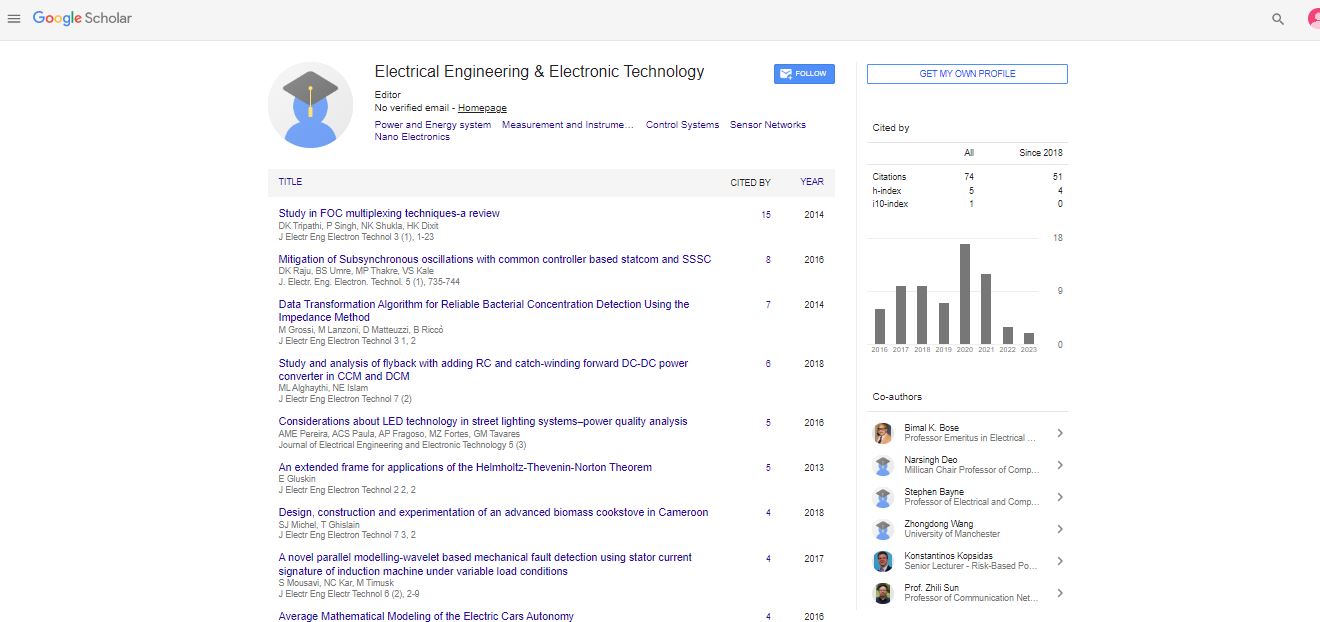Opinion Article, J Electr Eng Electron Technol Vol: 13 Issue: 4
Circuits, Devices and Systems: The Structure Blocks of Modern Electronics
Jack Rarick*
1Department of Electrical and Computer Engineering, Cleveland State University, OH, USA
*Corresponding Author: Jack Rarick,
Department of Electrical and Computer
Engineering, Cleveland State University, OH, USA
E-mail: jackr@mail.com
Received date: 21 June, 2024, Manuscript No. JEEET-24-143446;
Editor assigned date: 24 June, 2024, Pre QC No. JEEET-24-14346 (PQ);
Reviewed date: 8 July, 2024, QC No. JEEET-24-143446;
Revised date: 15 July, 2024, Manuscript No. JEEET-24-143446 (R);
Published date: 22 July, 2024, DOI: 0.4172/2325-9838.1000982
Citation: Rarick J (2024) Circuits, Devices and Systems: The Structure Blocks of Modern Electronics. J Electr Eng Electron Technol 13:4.
Description
In the world of electronics, the concepts of circuits, devices and systems are fundamental to understanding how technology operates. From powering everyday gadgets to enabling complex industrial machinery, these building blocks play important roles in modern technology. This article explores the essential components of circuits, devices and systems, highlighting their functions and significance in contemporary electronics. Circuits are the foundational structures of electronic systems. They consist of interconnected electronic components that allow the flow of electrical current to perform specific functions. Circuits can be as simple as those found in a flashlight or as complex as those used in a computer's motherboard.
Types of circuits
Analog circuits can handle continuous signals and are used in applications such as audio amplification and radio transmission. They operate with varying voltage levels and are essential for tasks where precise signal processing is required. Digital circuits work with discrete signals and are fundamental in modern computing and digital communication. They process binary data (0s and 1s) and are used in devices like smartphones, computers and digital watches. Mixedsignal circuits these circuits combine both analog and digital elements to manage a range of signals. They are important in applications like data converters and sensor interfaces where both types of signals need to be processed.
Resistors limit the flow of electrical current and set voltage levels within the circuit. Capacitors Store and release electrical energy, smooth out voltage fluctuations and filter signals. Inductors Store energy in a magnetic field and are used in filtering and tuning applications. Transistors Act as switches or amplifiers, controlling the flow of current in a circuit.
Devices: The functional elements
Devices are individual components that perform specific functions within an electronic circuit. They are the practical elements that implement the desired behavior of a circuit. Semiconductors these materials, such as silicon, have electrical conductivity between conductors and insulators. Semiconductors are used in a variety of devices, including diodes, transistors and integrated circuits. They form the backbone of modern electronics by enabling switching and amplification. Diodes allow current to flow in one direction only, used for rectification and signal demodulation. Transistors as mentioned, these can act as switches or amplifiers. They are essential for digital logic operations and signal amplification. Integrated Circuits (ICs) combine multiple electronic components into a single package, performing complex functions like arithmetic operations or signal processing in a compact form. Sensors Convert physical parameters (such as temperature, light, or motion) into electrical signals that can be processed by a circuit.
Systems: The integrated solutions
Systems represent the combination of circuits and devices working together to perform complex tasks or solve specific problems. An electronic system typically includes several subsystems and components that interact to achieve a desired outcome. Communication Systems facilitate the transfer of information between different locations. Examples include cellular networks, satellite communications and wireless internet systems. These systems integrate circuits and devices to encode, transmit and decode signals efficiently. Control Systems manage and regulate the behavior of other systems. They are used in industrial automation, automotive systems and consumer electronics.
Control systems often include sensors, actuators and microcontrollers to monitor and adjust processes. Embedded Systems Specialized systems embedded within other devices to perform dedicated functions. Examples include the microcontroller in a microwave oven or the control unit in a car’s engine. These systems combine hardware and software to provide specific functionalities within larger applications. Power systems manage the generation, distribution and utilization of electrical power. This includes everything from power generation plants to the power supply units in electronic devices. Power systems ensure efficient energy conversion and distribution.
Innovations and trends
Advancements in technology continue to drive innovations in circuits, devices and systems. Miniaturization the trend toward smaller and more efficient components allows for more compact and portable electronic devices, from smartphones to wearable technology. Smart systems integration of Artificial Intelligence (AI) and machine learning into electronic systems enables smarter and more adaptive technologies, such as autonomous vehicles and smart home devices. Flexible electronics development of flexible and stretchable electronic materials opens new possibilities for wearable devices and flexible displays. Internet of Things (IoT) Expanding the network of connected devices and systems, IoT is transforming industries by enabling realtime data exchange and automation.
 Spanish
Spanish  Chinese
Chinese  Russian
Russian  German
German  French
French  Japanese
Japanese  Portuguese
Portuguese  Hindi
Hindi 
